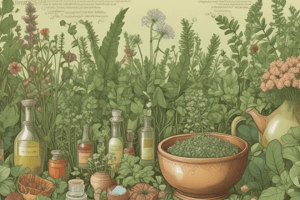Podcast
Questions and Answers
What is the primary purpose of drying in the processing of plants?
What is the primary purpose of drying in the processing of plants?
- To separate leaves from stems
- To wash plants clean
- To powder plants for analysis
- To remove water content from plants for storage (correct)
What method of drying requires large number of workers for loading and unloading?
What method of drying requires large number of workers for loading and unloading?
- Sun-drying
- Serial exhaustive extraction
- Natural process
- Artificial drying (correct)
What is the purpose of powdering plants after drying?
What is the purpose of powdering plants after drying?
- To store plants for long periods
- To extract plant tissue
- To wash plants clean
- For further analysis (correct)
What happens if plants are not dried immediately after collection?
What happens if plants are not dried immediately after collection?
What is involved in the natural process of drying?
What is involved in the natural process of drying?
What method of extraction involves grinding plant parts in a blender?
What method of extraction involves grinding plant parts in a blender?
What is the primary advantage of collecting plants from wild forests?
What is the primary advantage of collecting plants from wild forests?
Why is it necessary to clean plants by hand?
Why is it necessary to clean plants by hand?
What is the purpose of filtering the extract in plant tissue homogenization?
What is the purpose of filtering the extract in plant tissue homogenization?
What is the main purpose of cleaning plants after collection?
What is the main purpose of cleaning plants after collection?
What is the term used to describe medicines derived from phytochemicals?
What is the term used to describe medicines derived from phytochemicals?
What is the purpose of qualitative analysis of phytochemicals?
What is the purpose of qualitative analysis of phytochemicals?
What are phytochemicals used for in the pharmaceutical industry?
What are phytochemicals used for in the pharmaceutical industry?
Why are phytochemicals becoming increasingly popular?
Why are phytochemicals becoming increasingly popular?
What is the risk associated with collecting plants from wild forests?
What is the risk associated with collecting plants from wild forests?
What is the term used to describe the biologically active compounds present in plants?
What is the term used to describe the biologically active compounds present in plants?
Flashcards are hidden until you start studying
Study Notes
Phytochemicals and Their Significance
- Phytochemicals are biologically active compounds present in plants, known for their structural diversity and wide range of pharmacological activities.
- These compounds are derived from various parts of plants, such as leaves, flowers, seeds, barks, roots, and pulps.
- Phytochemicals serve as sources of direct medicinal agents and as a raw material base for the elaboration of more complex semi-synthetic chemical compounds.
Plant Collection and Preparation
- Plants can be collected from wild forests or herbariums, but those collected from wild forests may be incorrectly identified.
- Collected plants must be processed for cleaning to prevent deterioration of phytochemicals.
- Cleaning involves steps such as cleaning, washing, peeling, or stripping leaves from stems, and must be done by hand for better results.
- Drying is essential to remove water content from plants, and can be done either naturally (sun-drying) or artificially (using artificial driers).
- Artificial drying methods, such as warm-air drying, can reduce drying time to several hours or minutes.
Drying Methods
- Natural drying methods include sun-drying, which may take few weeks, depending on temperature and humidity.
- Artificial drying methods include warm-air drying, which is applicable to fragile flower and leaves, but requires a large number of workers.
Powdering and Extraction
- After complete drying, plants must be powdered well for further analysis.
- Plant tissue homogenization in solvent is a widely used method of extraction, involving grinding plant parts to fine particles and shaking them vigorously in a solvent.
- Serial exhaustive extraction is another common method of extraction, which involves repeated extraction of plant parts with solvents of increasing polarity.
Importance of Phytochemicals
- Phytochemicals have countless medicinal uses, such as curing diseases like asthma, arthritis, and cancer, without causing any side effects.
- Phytochemicals can be considered "man-friendly medicines" due to their ability to cure diseases without harming human beings.
Studying That Suits You
Use AI to generate personalized quizzes and flashcards to suit your learning preferences.




